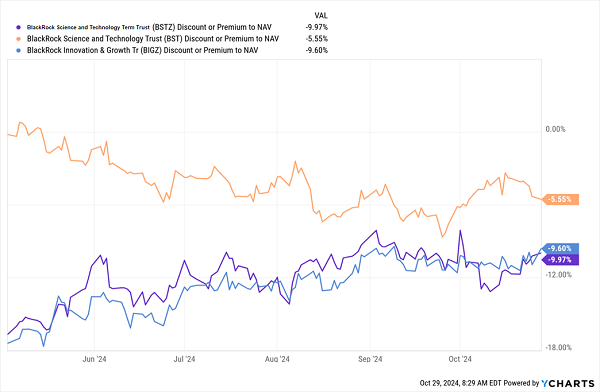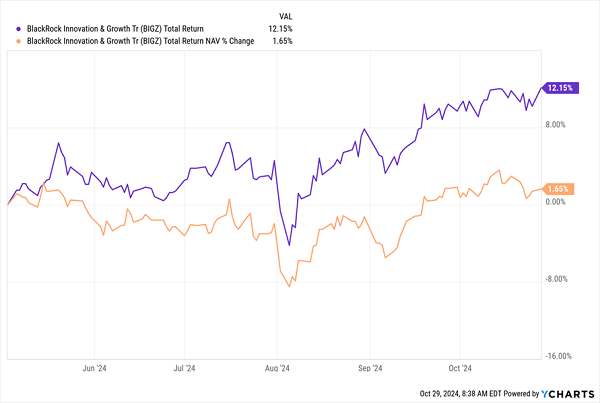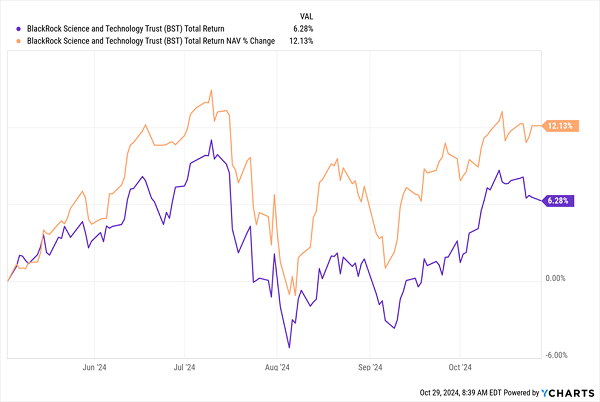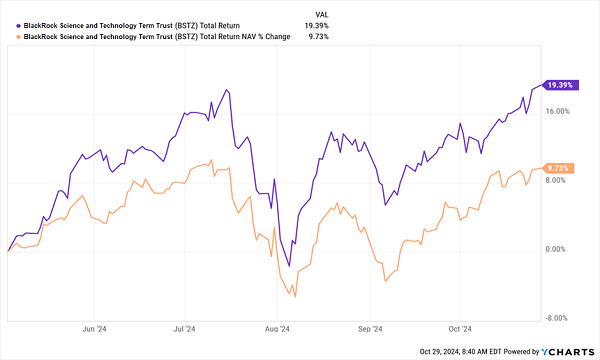One often-overlooked way for closed-end funds (CEFs) to give us a profit boost is for management to buy back a fund’s shares.
By now, buybacks are probably familiar to most investors: With “regular” stocks, buybacks reduce a company’s share count, which boosts earnings per share and other per-share metrics, indirectly boosting share prices.
With CEFs, buybacks have a bit of a different effect. With these high-yielding funds, we want to focus instead on how buybacks affect the discount to net asset value (NAV, or the value of a CEF’s underlying portfolio).
Buybacks, Fixed Share Counts Help Management “Control” CEF Discounts
Members of my CEF Insider service know that we love discounts to NAV because they’re the primary indicator of CEF value. We can buy discounted CEFs, then “ride along” as the discount closes, propelling the fund’s price higher as it does.
These discounts originate from the fact that CEFs have fixed share counts, so their market prices can—and regularly do—trade at different levels than their portfolios. And they regularly trade at discounts.
I’m bringing this up now because back in May we dug into an unexpected move from BlackRock that I said would help put a floor under the firm’s CEF discounts and boost their market prices
The move? Early this year, BlackRock announced a program (also known as a “tender offer” because the firm is inviting investors to tender their shares) to buy back shares of 14 of their CEFs at 98% of NAV once a fund’s discount is at or below 7.5% over a three-month measurement period.
This is great for investors, since they get to sell their shares to the BlackRock fund at essentially a 2% discount to NAV. If they bought at a bigger discount, that’s instant profit.
Since then, we’ve seen some erosion of these funds’ discounts. But more importantly, bigger gains and more downside protection for shareholders.
BlackRock Discounts Shrinking Slowly

Above we see the moves in the discounts of three BlackRock tech funds since the buyback plan was announced: the BlackRock Science and Technology Trust (BST), in orange; BlackRock Science and Technology Term Trust (BSTZ), in purple, and the BlackRock Innovation and Growth Trust (BIGZ), in blue.
Two of these funds, BST and BSTZ, are CEF Insider holdings.
In this chart, we can see that BST has stayed at around a 5% discount on average. That’s easily explained by the 7.5%+ discount limit on BlackRock’s buyback program. BST simply hasn’t been eligible.
But that’s a good thing—it means BST’s discount hasn’t moved below 7.5% in a sustained way, so investors who buy more when it flirts with such a discount have seen less volatility.
The buyback program, however, has helped BIGZ much more; its market price (in purple below) has soared since news of the plan broke, far outstripping its nearly flat total NAV return (in orange).
BIGZ’s Returns Prove the Buyback Program Is Working

If we stop to ponder this, we can see how successful BlackRock’s plan has been. This year has been great for stocks, and for growth stocks, in particular, so BIGZ’s NAV should be soaring.
Instead, its NAV has flatlined, which should result in investors exchanging the fund for something better, like BST, which has seen its market price–based return (in purple below) and its NAV return (in orange) rise in the last six months:
BST Benefits From Buybacks and Fundamentals

But remember, BST isn’t benefiting from the buyback program directly, as its discount isn’t big enough. This explains why the NAV and price returns are close to each other. Out of this trio, the fund that’s benefiting the most from the tender offer is BSTZ:
BSTZ Gains as Its Discount Shrinks

As BSTZ’s discount has shrunk from 17% to around 10% as of this writing, the fund’s 9.7% total NAV return (in orange above) has been significantly compounded, giving investors a 19.4% return, based on the fund’s market price (in purple).
This is why I urged CEF Insider members to buy BSTZ in the May issue, after the tender offer was announced. With BSTZ’s discount still around 10%, there’s a ways to go for investors to buy into this fund and profit from the real floor for BSTZ’s discount: 7.5%.
What Makes BlackRock’s Buyback Program Work
Before we go further, it’s worth bearing in mind the two reasons why we love CEFs: the high yields—of course! (BSTZ yields an outsized 12.8% today, while BST yields 8.3%) and their steep discounts to NAV. But bear in mind that a steep NAV discount is great for buying, not so much for selling. That’s why we want our CEFs’ discount to NAV to fluctuate a fair bit, so we can sell at a narrower discount and take profits.
Buyback programs can play a role here: BlackRock’s approach allows the fund’s manager to buy back any shares owned by investors in the fund at a fixed discount, as mentioned, so investors who wish to walk away from the fund have better odds of doing so while making a quick profit. But investors who stay in the fund also benefit, because the fund essentially gets to retire those shares at a discount. And the 2% discount accrues to shareholders, so the NAV of the overall fund goes up a bit.
For instance, if you buy BSTZ today at a 10% discount and sell at a 2% discount, that’s an instant 8.8% profit. Bear in mind, though, that BlackRock’s program is highly competitive, as the company is only offering buybacks of up to 2.5% of outstanding shares per quarter, so you’ll need to contact your broker ASAP to benefit.
All in all, the BlackRock program is great for shareholders of BIGZ, BST and BSTZ, but I do worry that it seems to be offsetting lackluster performance at BIGZ. The market isn’t really in a mood to care, as it’s riding the buyback train, so if there’s a turnaround in BIGZ’s NAV, this fund could soar.
Huge 9.8% Dividends From … AI?!
Few people realize it, but CEFs are practically the only way to invest in AI’s continued growth and get an outsized dividend yield in return.
Individual stocks? They just don’t cut it: AI poster boys like NVIDIA (NVDA), Microsoft (MSFT) and the like yield next to nothing.
That’s NOT the case with the 4 “AI-Powered” CEFs I’m pounding the table on now.
They yield an incredible 9.8% on average today, and they’re ALL cheap—so much so that they essentially let us buy the AI stocks in their portfolios at prices that haven’t been available to “regular” investors for months.
Now is the time to buy these 4 impressive funds and set ourselves up for big dividends, and upside, as AI embeds itself in our day-to-day lives.
Click here and I’ll tell you more about these 9.8%-paying AI funds and give you an opportunity to download a free Special Report revealing their names and tickers.
Before you make your next trade, you'll want to hear this.
MarketBeat keeps track of Wall Street's top-rated and best performing research analysts and the stocks they recommend to their clients on a daily basis.
Our team has identified the five stocks that top analysts are quietly whispering to their clients to buy now before the broader market catches on... and none of the big name stocks were on the list.
They believe these five stocks are the five best companies for investors to buy now...
See The Five Stocks Here
Just getting into the stock market? These 10 simple stocks can help beginning investors build long-term wealth without knowing options, technicals, or other advanced strategies.
Get This Free Report